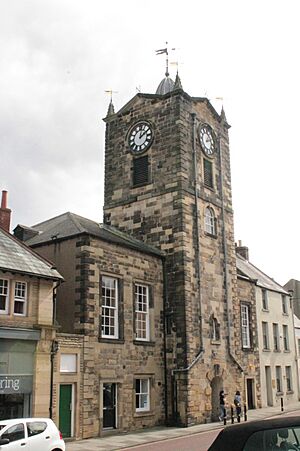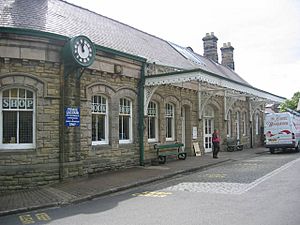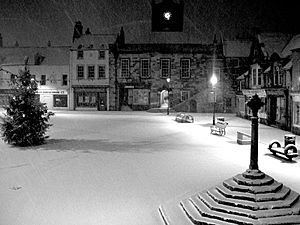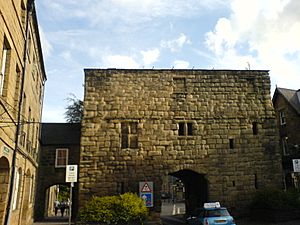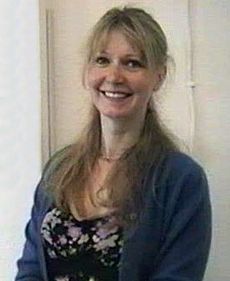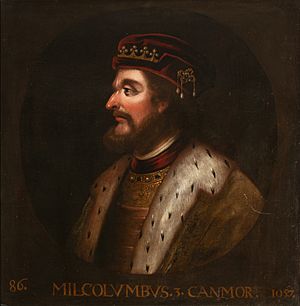Alnwick facts for kids
Quick facts for kids Alnwick |
|
|---|---|
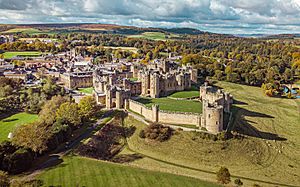 The town of Alnwick, including Alnwick Castle |
|
| Population | 8,116 (2011 census) |
| OS grid reference | NU186129 |
| Civil parish |
|
| Unitary authority |
|
| Ceremonial county | |
| Region | |
| Country | England |
| Sovereign state | United Kingdom |
| Post town | ALNWICK |
| Postcode district | NE66 |
| Dialling code | 01665 |
| Police | Northumbria |
| Fire | Northumberland |
| Ambulance | North East |
| EU Parliament | North East England |
| UK Parliament |
|
Alnwick (pronounced AN-ik) is a lively market town in Northumberland, England. It's known as the traditional county town of Northumberland. In 2011, about 8,116 people lived there.
The town sits on the south side of the River Aln. It's about 32 miles (51 km) south of Berwick-upon-Tweed and the Scottish border. The North Sea is just 5 miles (8 km) away at Alnmouth. Alnwick is also about 34 miles (55 km) north of Newcastle upon Tyne.
Alnwick has been around since about 600 AD. It grew into an important farming area. Alnwick Castle was once home to the powerful Percy family, who were the Earls of Northumberland. The town was also a key stop on the Great North Road, which connected Edinburgh and London. While the town centre still looks much like it used to, Alnwick has grown with new homes and businesses.
Contents
- Discovering Alnwick's Past
- Alnwick's Location
- How Alnwick is Governed
- Local Businesses and Jobs
- Learning in Alnwick
- Famous Places in Alnwick
- Sports Teams
- Local News and Media
- Events in Alnwick
- Getting Around Alnwick
- Sister Cities
- Famous People from Alnwick
- Filming Location
- Freedom of the Town
- See also
Discovering Alnwick's Past
The name Alnwick comes from old English words. Wic means 'dairy farm' or 'settlement'. This was combined with the name of the River Aln.

The story of Alnwick is closely tied to its famous castle and the important families who lived there. One of the first owners was Gilbert Tyson, a flag-bearer for William the Conqueror. Later, the De Vesci family owned it for over 200 years. In 1309, the castle passed to the powerful House of Percy.
Ivo de Vesci first built the castle from timber around 1096. It was captured by David I of Scotland in 1136. Around the same time, Alnwick Abbey was built for canons (a type of priest) near the castle. The castle was then rebuilt using stone.
You can find memorials around Alnwick that remind us of the many wars with Scotland. The Percy family spent much of their lives fighting in these battles. A cross near Broomhouse Hill marks where Malcolm III of Scotland was killed in 1093. This was during the first Battle of Alnwick. Another stone tablet marks where William the Lion of Scotland was captured in 1174. This happened during the second Battle of Alnwick.
Hulne Priory is a old monastery outside the town walls. It was built around 1240 for the Carmelites (a religious order). People say the spot was chosen because it looked a bit like Mount Carmel, where the order started.
In the 14th century, the Percy family made many improvements to Alnwick Castle. They added new towers and strong gates. However, after the Percys challenged King Henry IV, the king took the castle in 1403.
In 1424, Scottish raiders burned much of the town. It was burned again in 1448 by a Scottish army. After these attacks, the town built walls for protection. The monasteries also added defensive towers.
Alnwick was also a key battleground during the Wars of the Roses in England. It was attacked and taken many times by both sides. One historian said Alnwick was the most besieged place in the country during these wars.
During the English Reformation, the monasteries in Alnwick closed down in 1539. The Percy family also left the castle for a while. They returned in the mid-1700s and have lived there ever since.
During the Second World War, a fuel storage depot was built in Alnwick. It had large tanks for fuel. This site closed in the 1970s. The A1 London–Edinburgh trunk road now goes around the town. This bypass was started in 1968.
Alnwick's Location
Alnwick is located at 55.417°N, -1.700°W. The River Aln forms its northern border.
How Alnwick is Governed
Historically, Alnwick was part of different local areas. The Alnwick Town Hall was where the town council met. In 2011, a special voting area (ward) covered part of Alnwick parish. Its population was 4,766 people.
Local Businesses and Jobs
Some important businesses in Alnwick include:
- Barter Books: This is one of England's largest second-hand bookshops. It's located in the town's old railway station.
- Quotient Sciences Alnwick: A big centre for making, researching, and testing medicines.
- NFU Mutual: A company that provides insurance, pensions, and investments.
- Department for Environment, Food and Rural Affairs: A government department.
- House of Hardy, Fly Fishing Gear: A famous brand for fly fishing equipment.
Learning in Alnwick
The main secondary school in Alnwick is The Duchess's Community High School.
Famous Places in Alnwick
The most famous building in Alnwick is Alnwick Castle. It's one of the homes of the Duke of Northumberland. The castle also has the amazing The Alnwick Garden. The castle grounds were designed by Capability Brown. They include old ruins like St Leonard's Hospital, Alnwick Abbey, and Hulne Priory.
The town centre is the marketplace. Here you'll find the market cross and the Northumberland Hall, which is used for meetings.
The Alnwick Playhouse is a busy arts centre. It hosts theatre, dance, music, movies, and art shows.
In 2003, the Willowburn Leisure Centre opened. It's a modern sports centre on the edge of town.
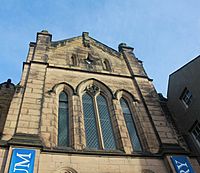
Alnwick's museum is the Bailiffgate Museum. It's near the castle entrance. The museum tells the story of local life. It has many old farming tools, household items, railway objects, and photos. There are also fun activities for children.
Other interesting places in and near Alnwick include:

- The Bondgate Tower: Also called the Hotspur Tower, it's the only remaining part of the medieval town wall. It's named after Sir Henry 'Hotspur' Percy.
- Brizlee Tower: A tall, decorative tower (called a folly) in Hulne Park. It was designed in 1777 and offers great views.
- Camphill Column: Built in 1814 to celebrate British victories in Europe.
- The Fusiliers Museum of Northumberland: Located inside Alnwick Castle.
- The Pottergate Tower: A decorative tower from 1768 on the site of an old medieval gate.
- RAF Boulmer: An old airfield from World War II. Now it helps with radar and communications.
- St Michael's Church: The main church in town, dating back to the 15th century.
- The Tenantry Column: A tall column, 83 feet (25 m) high, topped with the Percy Lion. It was built in 1816 to thank the Duke of Northumberland.
- The White Swan Hotel: An old coaching inn. It has the First Class Lounge and other parts from the Titanic's sister ship, RMS Olympic.
Sports Teams
- Alnwick RFC (Rugby Football Club)
- Alnwick Town A.F.C. (Association Football Club)
Local News and Media
Local news and TV shows for Alnwick come from BBC North East and Cumbria and ITV Tyne Tees.
Alnwick has several local radio stations: BBC Radio Newcastle (96.0 FM), Hits Radio North East (102.6 FM), and Lionheart Radio (107.3 FM), which is a community station.
The Northumberland Gazette is the town's local newspaper.
Events in Alnwick
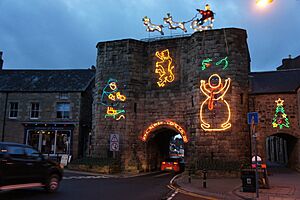
The Alnwick Fair used to be an annual event. From 1969 to 2007, people would dress up and recreate old trading and farming fairs. This event is no longer held.
Getting Around Alnwick
Road Travel
Alnwick is right next to the A1, which is the main road connecting London and Edinburgh. This makes it easy to reach Newcastle upon Tyne (about 35 miles or 56 km south) and Edinburgh (about 80 miles or 129 km north).
Train Travel
The East Coast Main Line train route runs through Alnmouth for Alnwick Station. This station is about 4 miles (6 km) from Alnwick. You can get to Edinburgh in about 1 hour 10 minutes. A trip to London takes about 3 hours 45 minutes. There are many trains each day.
The Alnwick branch line used to connect Alnwick's own station to Alnmouth. This line closed in 1968. Since the 2010s, a group called the Aln Valley Railway Trust has been working to reopen it as a heritage railway. They built a new station called Alnwick Lionheart terminus on the edge of town. The project is still ongoing.
Air Travel
Newcastle Airport is about 45 minutes away by car. It offers many daily flights to London and other UK cities.
Sister Cities
Alnwick is twinned with these towns:
- Bryne, Norway
- Lagny-sur-Marne, France
- Voerde, Germany
Famous People from Alnwick
Born in Alnwick
- Henry 'Hotspur' Percy (1364?–1403): A famous knight and son of the 1st Earl of Northumberland.
- George Biddell Airy (1801–1892): The Astronomer Royal from 1835 to 1881.
- James Patterson (1833–1895): An Australian politician who became premier of Victoria.
- Bernard Bosanquet (1848–1923): A well-known philosopher.
- Sid Waddell (1940–2012): A popular sports commentator and TV personality.
- Stella Vine (born 1969): An artist.
- Laura Weightman (born 1991): A former British middle-distance runner and Olympic athlete.
- Kelland Watts (born 1999): A professional footballer.
Lived in Alnwick
- Lucy Bronze (born 1991): A famous footballer for Barcelona and England. She played junior football in Alnwick.
Died in Alnwick
- Malcolm III of Scotland (died 1093): The King of Scotland.
Filming Location
Alnwick town has been used as a setting for movies and TV shows.
- Films
- 2000: Harry Potter (parts filmed at Alnwick Castle)
- 2011: Your Highness
- 2012: Villains
- Television
- 1987: Treasure Hunt (Northumberland episode)
- 1991–1993: Spender
- 1998-2011: History's Mysteries (Episode: Doomed Sisters of the Titanic)
- 2011-: All Over the Place (Episodes: Tree Houses, Buses and Pie Eating!; Scary Castles, Teapots and Onion Eating!)
- 2013-: The Other Child
- 2014: Vera (Series 4, Episode 1: On Harbour Street)
- 2015: Vera (Series 5, Episode 3: Muddy Waters) – a scene was filmed in Alnwick's market place during a real market.
- 2013-: Tales from Northumberland with Robson Green (Episode: More Tales from Northumberland with Robson Green: Industrial Heritage)
- 2018-: The Heist
- 2012-: Chris Tarrant: Extreme Railways (Episode: Chris Tarrant: Railways of the Somme)
Freedom of the Town
Some people have been given the special honour of "Freedom of the Town" of Alnwick. This is a way to recognize their important contributions.
- Bill Batey: 2019
- Adrian Ions: 12 November 2021
- William "Bill" Hugonin: 18 March 2022.
See also
 In Spanish: Alnwick para niños
In Spanish: Alnwick para niños



